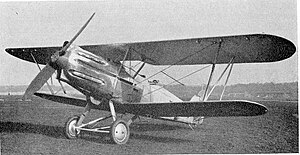Hawker Hector
| Hector | |
|---|---|

| |
| Role | Army co-operation |
| Manufacturer | Hawker Aircraft |
| First flight | 14 February 1936 |
| Status | retired |
| Primary users | Royal Air Force Irish Air Corps |
| Number built | 179 (including 1 prototype)[1] |
| Developed from | Hawker Hart |
The Hawker Hector was a British biplane army co-operation and liaison aircraft of the late 1930s; it served with the Royal Air Force and saw brief combat in the Battle of France in May 1940. Some Hectors were later sold to Ireland. It was named after the Trojan prince Hector.
Design and development
The Hector was intended as a replacement for the
Operational service
Starting in February 1937, the Hector began equipping the seven
The
Variants
- Hector Mk I : Two-seat army co-operation aircraft for the RAF.
Operators
Specifications (Hector)
Data from Hawker Aircraft since 1920 [5]
General characteristics
- Crew: Two
- Length: 29 ft 9+3⁄4 in (9.09 m)
- Upper wingspan: 36 ft 11+1⁄2 in (11.26 m)
- Lower wingspan: 31 ft 4 in (9.55 m)
- Height: 10 ft 5 in (3.18 m)
- Wing area: 346 sq ft (32.1 m2) [6]
- Empty weight: 3,389 lb (1,537 kg)
- Gross weight: 4,910 lb (2,227 kg)
- Powerplant: 1 × Napier Dagger III 24-cylinder air-cooled H-block engine, 805 hp (600 kW)
- Propellers: 2-bladed fixed pitch wooden propeller
Performance
- Maximum speed: 187 mph (301 km/h, 162 kn) at 6,600 ft (2,000 m)
- Stall speed: 50 mph (80 km/h, 44 kn) [7]
- Range: 300 mi (480 km, 261 nmi) [6]
- Service ceiling: 24,000 ft (7,300 m)
- Time to altitude: 5 minutes 40 seconds to 10,000 ft (3,000 m)
Armament
- Guns: ** 1 × forward-firing .303 in (7.7 mm) Vickers machine gun Mk.V
- 1 × .303 in (7.7 mm) Lewis gun in the rear cockpit on a Hawker mount
- Bombs: Mountings for a camera, flares, and 2 × 112 lb (51 kg) bombs (or containers)
Surviving aircraft
In 1996, an ex-Irish Air Corps Hector 88 (ex RAF K8130) was recovered for eventual restoration from near Dundrum in Ireland.[8]
Parts of Hector K8096 remain on Red Pike in the English Lake District. The aircraft crashed on 8 September 1941, killing its pilot.[9]
See also
Related development
- Hawker Hart
- Hawker Audax
Aircraft of comparable role, configuration, and era
Related lists
References
Citations
- ^ "Hawker Hector". BAE Systems. Retrieved 1 August 2023.
- ^ Jackson, 2006, p.61
- ^ a b Thetford, 1962, p.304
- ^ Halley 1980, p. 352.
- ^ Mason 1991, p.265–266.
- ^ a b Mason 1994, p.281
- ^ ATA Ferry Pilots Notes 1996
- ^ Simpson, 2013
- ^ "Hector K8096 on Red Pike, Wasdale". Aircraft accidents in the English Lake District. Yorkshire Aircraft. Archived from the original on 29 May 2011. Retrieved 7 August 2015.
Bibliography
- Air Transport Auxiliary Ferry Pilots Notes (reproduction). Elvington, York, UK: Yorkshire Air Museum, 1996. ISBN 0-9512379-8-5.
- Crawford, Alex. Hawker Hart Family. Redbourn, Hertfordshire, UK: Mushroom Model Publications Ltd., 2008. ISBN 83-89450-62-3.
- Halley, James J. The Squadrons of the Royal Air Force. Tonbridge, Kent, UK: Air Britain (Historians), 1980. ISBN 0-85130-083-9.
- Jackson, Robert (2006). Army Wings: A History of Army Air Observation Flying 1914–1960. Pen & Sword Books. p. 61. ISBN 978-1-84415-380-0.
- Mason, Francis K. Hawker Aircraft since 1920. London: Putnam, 1961 (Third revised Edition 1991). ISBN 0-85177-839-9.
- Mason, Francis K. The British Bomber since 1914. London: Putnam. 1994. ISBN 0-85177-861-5.
- Simpson, Andrew (2013). "A/C Serial No. BAPC82 Section 2B Individual History Hawker Hind (Afghan) BAPC 82 Museum Accession No.69/A/104" (PDF). Royal Air Force Museum. Retrieved 7 August 2015.
- Thetford, Owen Gordon (1962). Aircraft of the Royal Air Force since 1918. Putnam. p. 304. OCLC 816338199.
